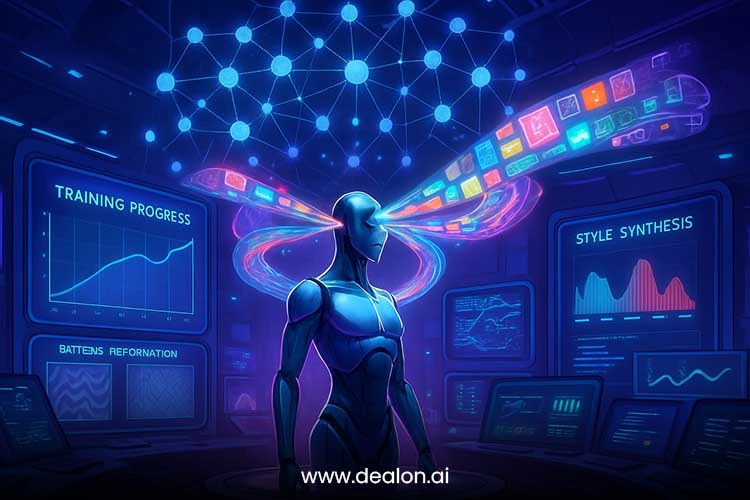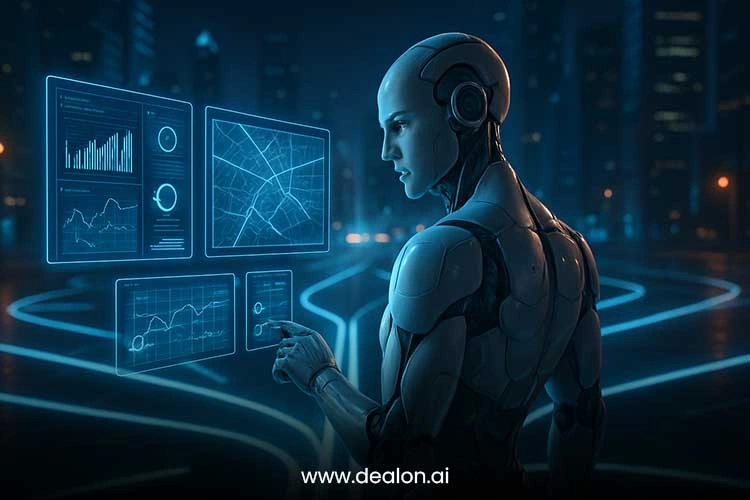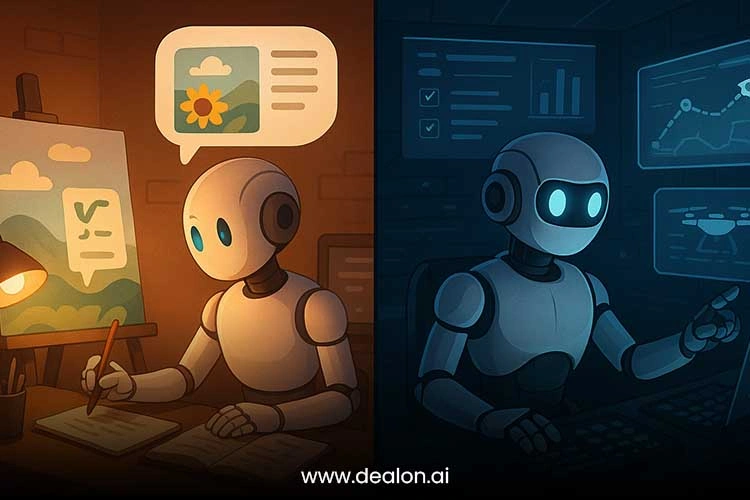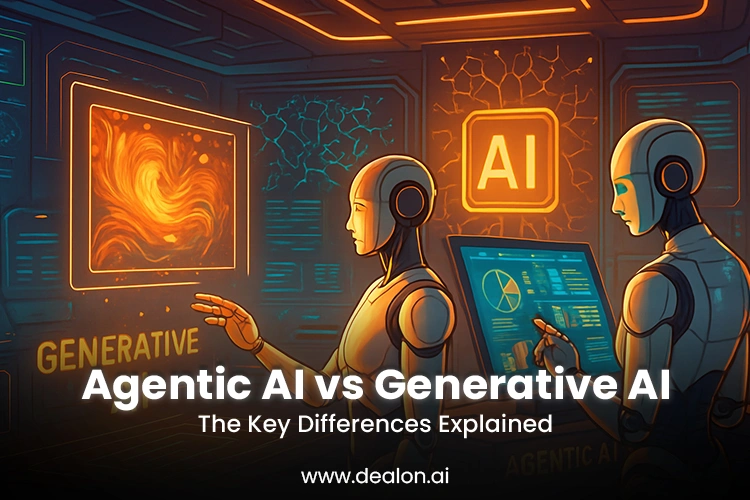Generative AI and Agentic AI are the two paradigms of artificial intelligence currently seen as the founders of modern innovation, being intertwined and much misunderstood, but on an entirely different scale, purpose, and impact. Generative models like GPT, Midjourney, and Stable Diffusion became household names in recent years because they are now generating natural language, images, music, and code that are comparable to human creativity. And their specialties are in pattern recognition and synthesis, which enables these machines to imitate styles, duplicate structures, and even produce completely new things with unnerving accuracy. They are reactive, though, waiting to be told what to do before releasing their creative potential by human beings.
Agencies AI is, on the other hand, a paradigm shift that takes AI where the technology ceases to be a passive agent but becomes an active agent that makes decisions. In contrast to the creation of artifacts, agentic systems can sense changing environments, design plans, and perform tasks without human supervision. These models also have a self-generated notion of purposefulness and flexibility, which allows them to play the role of collaborators capable of making independent choices and even coordinating with other models, even those generative. This type of AI is not exclusive to content-generating programs; it is initiative, reason, and self-responsible.
The interaction between the two classes of AI is making a technological renaissance whose implications are way beyond creativity. Generative AI has opened up innovation, and all can now create content and ideas. Instead, agentic AI is set to transform industries and take on the role of analysis, decision-making, and execution, which until recently needed human control. It would be essential to learn how these two paradigms differ because the intersection of these two terms will shape the next decade in AI, as machines will become self-governing partners rather than mere instruments.
Also Read: Who is Smarter Than an AI Assistant in 2025: ChatGPT vs Claude?
Creativity at Scale: How to Train Generative AI

The concept of generative AI has emerged as one of the most powerful technologies of the contemporary digital age, and it is altering the perimeter of what is achievable in terms of creativity and problem-solving. In its simplest form, generative AI refers to machine learning systems that are trained with vast amounts of data so that they may generate new text, audio, code, video, and images instead of being conditioned to classify or predict merely. Such models are able to create new artifacts by internalizing enormous patterns of structure and style, such that producing a new creation has the feel of being done by a human being.
In contrast to conventional algorithms, which need to be guided by definite rules, generative models embody a profitability in probabilistic thinking and synthesis of patterns. Programs like GPT-4 and Stable Diffusion can combine context, language use, and style to produce text that sounds more natural, and their visual works can be elaborate compositions, design original music, and even help with software development. These models are stronger in their reactivity: they are ready to react when prompted by the user, and are very much reminded of the context given, being the best tools through which co-creation can be achieved.
The democratizing aspect that generative AI has is what sets it apart. It enables digital transformation by reducing the entry risks to creativity and enables personal and institutional owners to make ideas enter the prototype phase, model the ideas, and expand content generation, previously inconceivable. Marketers, architects, and educators, generative AI powers an ecosystem of high-velocity experimentation by allowing them to put their tools to generate highly differentiated results.
Although the systems do not have goals or intentions of their own, their ability to mimic and synthesize is unparalleled. Therefore, they make potent partners in areas of convergence of inspiration, style, and productivity. Generative AI is the age of augmented imagination, where human imagination is enhancing, extending, and redefining using algorithmic creativity.
Decoding Agentic AI: Autonomy and Decision-Making

Whereas generative AI has stayed within the boundaries of creating content, agentic AI is an evolutionary step into systems that move, respond, and choose. These are not just tools to follow a command; they are intelligent agents, and they are expected to sense the environment, compute a goal, and perform in a way that involves less input from a human being. When generative models are reactive, agentic models are proactive, which changes the relationship between human and machine from that of the tool to that of the operator, and takes it to being a collaborator and partners.
Agentic AI acts on the principles of intentionality. It is able to strategize multi-layered actions, dynamically evaluate blogged information, and change up strategies in real time. These models actively work on improving their comprehension by means of feedback loops, as a result of which they are capable of solving complicated issues, which presupposes reasoning, prior considerations, and self-guided exploration. Agents exist in comparing how a robotic swarm is coordinated in the manufacturing process, through the navigation of self-driving cars, to being able to fulfill roles as a personal digital assistant, where the decision-making capabilities are inbuilt in the architecture of AI.
Surprisingly, generative models are neither isolated to agentic AI, nor are they exceptional parts that only fit along with other parts; they are, in many cases, parts themselves that form part and parcel of agentic AI. As an example, a generative model could be used in an autonomous research system to draft hypotheses or compose reports. Still, decision-making about when, why, and how to activate the capabilities lies at the agentic layer.
The definitive power of agentic AI is its ability to be agentic, to initiate, to reason, to act, not to respond. These models would be the designers of digital ecosystems as they grow up, and can drive smaller tasks into other models and automatically iterate the indoor loop of perception and action. The new paradigm turns AI into adaptive companionship, transforming the way industries work, recreating the efficiency concept, and introducing new horizons in the work of people and machines.
The Big Difference: Generation VS Agency

Even though both generative AI and agentic AI have their basis as an extension of advanced machine learning architecture, the two fields are vastly different in their applications and behavioral patterns. The most crucial difference is the shift to autonomy- the shift between model-based artifact production and model-based initiation, planning, and execution.
Reactive AI is reactive. Generative AI lives on prompts: human beings give the context, and the model learns the pattern synthesis to generate a creation. It is, in fact, a collaborator in communication that goes round in a closed loop, starting and ending with the input of the user. Its creativity is in synthesis and style imitation; however, it is limited by human direction.
In contrast, agentic AI brings about the aspect of agency. These systems are able to implement their initiatives to achieve their goals, make related strategies, and wait to be told what to do. They go beyond the generation of outputs to the coordination of the actions, which frequently utilize generative models as secondary constituents. As an example, an agentic AI that was assigned to automate the processes related to the business can independently write emails (based on a generative model), conduct market research, schedule meetings, and adjust its activities in response to the changes in the circumstances without requiring constant human control.
This paradigm shift is what is changing AI, which was once a reactive assistive tool, to one that is a proactive collaborator. It shifts the technology of creative augmentation to strategic decision-making, where systems can decide not only what to create but also the manner in which to do so, as to when and why. In such a manner, the agentic AI is not limited to content production and yields a niche that requires inference, prioritizing, and situational awareness.
The distinction between generation and agency heralds, in the end, a new phase of evolution in artificial intelligence: the ability to personify creativity and initiative, to shift AI into the role of a true collaborative partner in the thinking process and the application of action.
Industry Implications and Society
The spillover of generative and agentic AI on the world industries is transformative, to say the least. Generative AI has already reallocated the definition of things, creativity, and productivity as it enables a seamless process in marketing, design, publishing, customer engagement, and entertainment. The models would allow others to run high-quality campaigns, images, and stories at scale by addressing the cost of creation to break down weeks into minutes and enabling individuals and organizations to produce them at scale. However, though this has been revolutionary, the next one, agentic AI, is also going to be more disruptive.
In the case of agentic AI systems, it is no longer about content creation but a dynamic orchestration of the whole process. These models can analyze data, make decisions, and perform actions without constant human guidance. In the industry, this translates to smart factories where machines plan on their own, logistics systems that plan by themselves in real time based on the current situation, and demand-predictive supply chains that plan ahead of human planners. In healthcare, agentic systems can handle individualized care programs, identify irregularities in patient records, and make resource distribution judgments across ecosystems in hospitals without manuals.
In science research, agentic AI holds the potential to become co-researchers and can design experiments, synthesize results, and cooperate with human researchers to make discoveries much faster. The combination of generative models with agentic structures implies not only AI controlling and planning but also offering creative solutions to specific situations in a context-dependent manner.
There are far-reaching social consequences that come with this change. Accountability, interpretability, and ethical supervision will emerge as the focus of the industries as they transfer an ever-larger proportion of decision-making duties to AI. Simultaneously, the combination of generative and agentic intelligence ushers in the era of joint ecosystems in which machine independence and human ingenuity intersect, resulting in productivity discontinuities, innovative problem-solving, and worldwide problem-solving.
The Hybrid- Generative and Agentic Future AI
Generative and agentic AI seem to represent entirely different paradigms, even though the industry is moving towards a hybrid version of intelligence that brings together the best of the two approaches. Generative models create creativity and pattern recognition, and agentic models provide structure and determinants of decision-making, planning, and actions. The combination of them results in a synergetic environment, where content is being generated and executed autonomously, and enhances each other.
When it comes to a hybrid future, an individual AI agent could apply generative models as domain-specific components: they could plan the marketing campaign, provide design prototypes, or synthesize an entire large dataset into some practical actions. These outputs will cease to be stagnant reactions; through the agentic layer, it will assess them, optimize them, and send them into processes without having to get more commands. In a corporate setting, an agentic system may produce reports, adapt strategies using real-time data, and initiate change in operations automatically, and at scale.
This merging effect may also change the way people work with artificial intelligence. Instead of taking AI as a passive assistant or a single tool of creativity, people will collaborate on ecosystems of intelligent agents that can ideate and execute all in one. These hybrids will be able to serve both as co-creators and autonomous managers, whether it is smart urban infrastructure or individualized systems of education.
Nonetheless, this consolidation puts new questions of control, trust, and disclosure. As these systems acquire the power to procreate as well as act, it becomes all the more important to ensure their alignment in line with human objectives. Future governance structures, ethics-related policies, and explainability tools are some of the key priorities that will emerge as hybrids start to influence decisions that have far-reaching consequences. Finally, the convergence of generative and agentic paradigms presages the dawn of an era of multifactorial AI, the one that goes beyond creativity and autonomy to provide entirely new systems, which are as agentic as they are inventive.
Conclusion
The shift towards agentic AI represents the paradigm shift in the contribution made by machines to human activities. Generative AI makes creativity more open to artists as its generation of content is incredibly fast and of high quality, and agentic AI creates autonomy, decision-making, and action towards a goal. All these models are changing the entertainment industry, the healthcare industry, and others, which are creating new solutions for efficiency.
With such converging paradigms, the creation and operation of systems that are intelligent enough to make yet robust enough to operate on our behalf will define our future, never more so than in the need to address these systems with a strong, ethical set of governance. Here, the thing is to get a feeling of how they differ in case you need to operate in a world where AI is not only a tool but also an active partner to work with.

